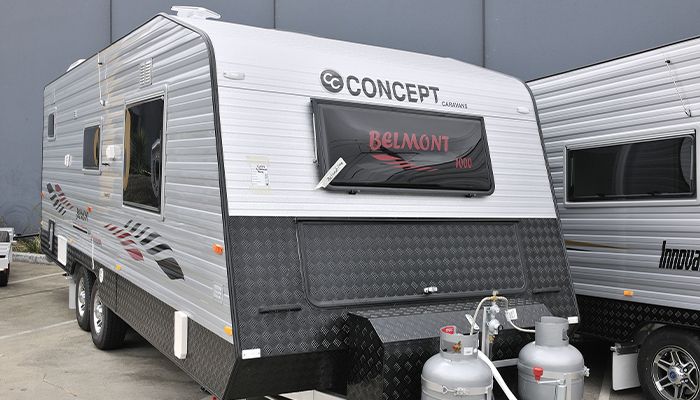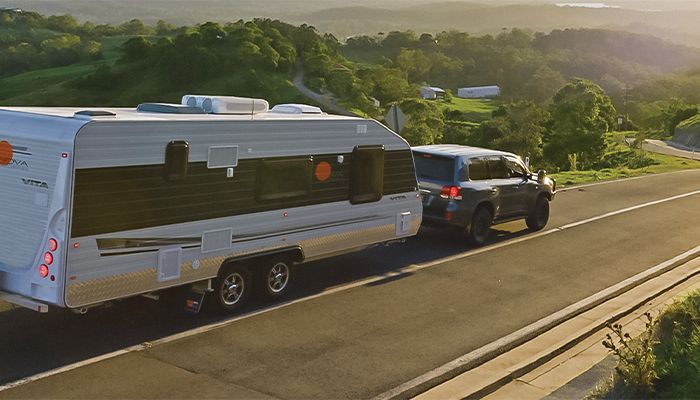Towing Your First Caravan - Five Tips For First Time Caravanners!
— June 08, 2021 | 2 min read
With COVID-19 restrictions limiting overseas travel, the Australian caravan market is stronger than ever. But with so many first time caravanners hitting the road, it’s important that the basics of towing a caravan are well understood.
If you’ve had very little towing experience, the thought of hitching up a caravan and setting off toward the horizon can seem a little daunting. We’ve put together five of our top tips for first time caravanners to help you with that process – and make sure you enjoy caravanning in a safer, and more stress-free manner.
1. Choosing the right tow vehicle
Because not every car can haul a caravan that might weigh 2,000kg or more, it’s important to know the tow rating of your vehicle – and the weight of your caravan plus any additional equipment you might be carrying. You need to avoid any situation where the caravan is heavier than the tow vehicle, and ensure the vehicle is compliant with towing rules and regulations (as this can also void your insurance policy should the worst happen).
Understand the manufacturer’s maximum towing capacity is key to choosing the right tow vehicle for your caravan. This figure determines how much your vehicle can tow, including any equipment stored in the caravan, and is referred to as Trailer Mass. By adding the Trailer Mass to the Vehicle Mass, which includes vehicle weight, fuel, passengers, and any equipment carried, you’ll know your rig’s Combination Mass. This figure must fall below the manufacturer’s listed Gross Combination Mass (GCM) which is usually available on the manufacturer’s placard.
Vehicle Mass (VM) + Trailer Mass (TM) = Combination Mass (CM) [<GCM]

2. Balancing your weight
Caravan or trailer sway is one of the riskiest things that can happen when towing. It’s usually caused by an improperly balanced caravan swaying side to side in a pendulum motion perpendicular to the direction of travel, and in extreme cases motion can overwhelm the stability of the tow vehicle and cause jack-knifing or even a vehicle roll-over.
By understanding how best to balance the caravan you can dramatically reduce the incidence of trailer sway. As a rule, heaviest items should be stored lowest and as close to (but not behind) the axle as possible with medium items below window height and again as close to the axle as possible. Lighter items can then be stored elsewhere, but wherever possible below window height.
Heaviest items = on the floor, closest to axle
Medium items = below window height, closest to axle
Lightest items = elsewhere, but preferably below window height and close to axle
3. Maintenance is critical
We’ve all seen a caravan, trailer, or boat trailer on the side of the highway missing a wheel. Usually this is because people forget that caravans and trailers need regular maintenance, much like the vehicles we use to tow them with. It’s a good idea to have your caravan’s wheel bearings, wheel nuts, tyres, brakes, and gas and electrical systems checked annually – especially if the caravan has been in storage for an extended period.
Always make sure your caravan’s tyres are at the correct pressure before setting off, and that the tread depth is within legal limits. Just as it’s unroadworthy to drive a car with incorrectly inflated or worn tyres, so too is it illegal to tow a caravan or trailer with incorrectly inflated or worn tyres. Your local caravan mechanic or service centre can help you understand what’s required if you’re at all unsure.
Checklist: Tyres, Wheel Nuts, Wheel Bearings, Brakes, Gas and Electrical Systems

4. Electronic assistants are important
One of the best advancements in caravanning in recent times is the introduction of trailer sway control to vehicles designed for towing. This technology utilises the vehicle’s electronic stability control and anti-lock braking systems to mitigate the severity of trailer sway, enabling the driver to control the fishtailing motion of their rig, and come to a stop more safely.
But there are other assistants that are equally important. Electric trailer brakes with adjustable braking rates (known as a trailer brake controller) are a massively important safety feature, as are trailer breakaway kits, which must now be fitted to any caravan or trailer exceeding 2,000kg Trailer Mass. This device activates electric trailer brakes in the event a caravan or trailer becomes unhitched when driving, bringing the caravan or trailer to a safe stop.
Tip: Check out the Projecta Sure Brake Trailer Breakaway Kit
The Projecta Sure Break trailer breakaway kit ensures safety in a towing disconnection emergency. It is a requirement in all Australian states that trailers exceeding 2000kg gross trailer mass be fitted with a breakaway system that, in the event of the trailer disconnecting while towing, will activate its electric brakes and bring it safely to a stop.
5. Try a towing course
We recommend anyone unfamiliar with towing or who is returning to towing after an extended period undertake a towing course. Knowing how to properly hitch your caravan or trailer, reverse and tow, turn and brake safely, and use your mirrors is critical to your safety and the safety of other road users. We also recommend your driving partner be equally familiar with towing just in case you’re ever tired or unwell.
Most state automotive bodies (AANT, NRMA, RAA, RAC, RACQ, RACT, RACV, etc.) provide towing courses to their members at a discounted rate, but private towing courses are also available from providers such as METEC and others. These courses provide theory and practical training to help you keep everything in check while towing and are undertaken in a closed environment so that you get plenty of practice before you hit the road.
Tip: Give a caravan course a crack!
